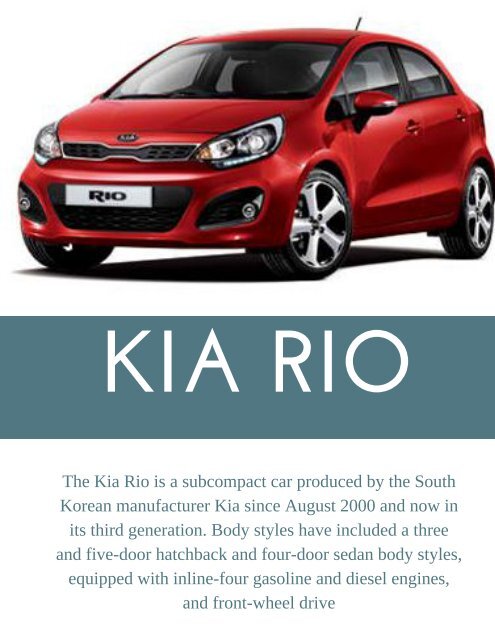Kia Rio
The Kia Rio is a subcompact car produced by the South Korean manufacturer Kia since August 2000 and now in its third generation. Body styles have included a three and five-door hatchback and four-door sedan body styles, equipped with inline-four gasoline and diesel engines, and front-wheel drive
The Kia Rio is a subcompact car produced by the South Korean manufacturer Kia since August 2000 and now in its third generation. Body styles have included a three and five-door hatchback and four-door sedan body styles, equipped with inline-four gasoline and diesel engines, and front-wheel drive
Create successful ePaper yourself
Turn your PDF publications into a flip-book with our unique Google optimized e-Paper software.
KIA RIO<br />
The <strong>Kia</strong> <strong>Rio</strong> is a subcompact car produced by the South<br />
Korean manufacturer <strong>Kia</strong> since August 2000 and now in<br />
its third generation. Body styles have included a three<br />
and five-door hatchback and four-door sedan body styles,<br />
equipped with inline-four gasoline and diesel engines,<br />
and front-wheel drive<br />
N O M A D I C | 2 4
FIRST GENERATION<br />
(DC; 2000–2005)<br />
The first-generation <strong>Kia</strong> <strong>Rio</strong> (referred to as the "DC") was offered in both four-door sedan and<br />
five-door station wagon body styles. When released, it was the least-expensive mass-produced<br />
car to be sold in the United States. While the <strong>Rio</strong>'s styling and affordability were well-received,<br />
it was derided for its poor build quality and driving experience.<br />
The station wagon was marketed as the "<strong>Rio</strong> Cinco" in the United States, "<strong>Rio</strong> RX-V" in<br />
Canada, and "<strong>Rio</strong> Look" in Chile. The sedan version was not sold in the United Kingdom, and<br />
the station wagon was known as the "<strong>Rio</strong>" there. In Greece, both versions were sold as the<br />
"<strong>Rio</strong>".<br />
The first-generation <strong>Rio</strong> offered only one engine for each model year in the USA: a 96 hp (72<br />
kW) 1.5-litre DOHC I4 gasoline engine from 2001 through 2002. Then a larger version<br />
appeared, a 1.6-litre DOHC four-cylinder rated at 104 hp (78 kW) used for model years 2003<br />
through 2005. All years offered a choice of a five-speed manual transmission or a four-speed<br />
F4A-EL automatic. An alternative of a 1.3-litre (1,343 cc) SOHC four-cylinder/eight-valve<br />
petrol, producing 75 hp (56 kW) was offered in some other countries, including the United<br />
Kingdom and most of continental Europe. The USA-version five-door featured power steering<br />
and a tachometer, optional on the sedan. The European version was marketed under several<br />
trim levels; standard equipment for all trims included a driver airbag. Additional features were<br />
available for promotion in Greece, including leather seats and car alarm. In Europe, the various<br />
national markets received different selections of the three engines.<br />
The domestic Korean market versions did not include the 1.6-liter version, as the South Korean<br />
taxation system heavily penalizes cars of more than 1,500 cc. Claimed outputs for the domestic<br />
versions (JIS) were higher, at 84 PS (62 kW) for the little 1.3 and 108 PS (79 kW) for the<br />
DOHC 1.5.[5] For the SOHC 1.5 95 PS (70 kW) was claimed. The first generation hatchback<br />
was marketed as the <strong>Rio</strong> RX-V in South Korea.<br />
Safety features included seat belts and an airbag for the driver. ABS was available as an option<br />
for entry-line cars but fitted by default for top of the range models (i.e., <strong>Rio</strong> LX, in the UK, and<br />
<strong>Rio</strong> LS, in Greece).
FIRST GENERATION<br />
(DC; 2000–2005)<br />
The first-generation <strong>Kia</strong> <strong>Rio</strong> (referred to as the "DC") was offered in both four-door sedan and<br />
five-door station wagon body styles. When released, it was the least-expensive mass-produced<br />
car to be sold in the United States. While the <strong>Rio</strong>'s styling and affordability were well-received,<br />
it was derided for its poor build quality and driving experience.<br />
The station wagon was marketed as the "<strong>Rio</strong> Cinco" in the United States, "<strong>Rio</strong> RX-V" in<br />
Canada, and "<strong>Rio</strong> Look" in Chile. The sedan version was not sold in the United Kingdom, and<br />
the station wagon was known as the "<strong>Rio</strong>" there. In Greece, both versions were sold as the<br />
"<strong>Rio</strong>".<br />
The first-generation <strong>Rio</strong> offered only one engine for each model year in the USA: a 96 hp (72<br />
kW) 1.5-litre DOHC I4 gasoline engine from 2001 through 2002. Then a larger version<br />
appeared, a 1.6-litre DOHC four-cylinder rated at 104 hp (78 kW) used for model years 2003<br />
through 2005. All years offered a choice of a five-speed manual transmission or a four-speed<br />
F4A-EL automatic. An alternative of a 1.3-litre (1,343 cc) SOHC four-cylinder/eight-valve<br />
petrol, producing 75 hp (56 kW) was offered in some other countries, including the United<br />
Kingdom and most of continental Europe. The USA-version five-door featured power steering<br />
and a tachometer, optional on the sedan. The European version was marketed under several<br />
trim levels; standard equipment for all trims included a driver airbag. Additional features were<br />
available for promotion in Greece, including leather seats and car alarm. In Europe, the various<br />
national markets received different selections of the three engines.<br />
The domestic Korean market versions did not include the 1.6-liter version, as the South Korean<br />
taxation system heavily penalizes cars of more than 1,500 cc. Claimed outputs for the domestic<br />
versions (JIS) were higher, at 84 PS (62 kW) for the little 1.3 and 108 PS (79 kW) for the<br />
DOHC 1.5.[5] For the SOHC 1.5 95 PS (70 kW) was claimed. The first generation hatchback<br />
was marketed as the <strong>Rio</strong> RX-V in South Korea.<br />
Safety features included seat belts and an airbag for the driver. ABS was available as an option<br />
for entry-line cars but fitted by default for top of the range models (i.e., <strong>Rio</strong> LX, in the UK, and<br />
<strong>Rio</strong> LS, in Greece).
SECOND GENERATION<br />
(JB; 2005–2011)<br />
<strong>Kia</strong> introduced the second generation (JB) in the early 2005 model year in Europe and for<br />
model year 2006 in North America, based on a redesigned platform shared with the Hyundai<br />
Accent. The engine was upgraded to a 110 hp 1.6-litre DOHC four-cylinder "Alpha II" engine<br />
now also shared with the Hyundai Accent. Other changes include a new exterior design, an<br />
increase in exterior size and interior volume, increased safety features and fuel economy. The<br />
hatchback was renamed to <strong>Rio</strong>5 in the USA and Canada.<br />
<strong>Kia</strong> offered the 2006 sedan as the <strong>Rio</strong> and <strong>Rio</strong> LX, the LX trim included power steering, air<br />
conditioning, and CD player. The <strong>Rio</strong>5 (USA) offered simply in SX trim level with leathercovered<br />
steering wheel. As in the first generation, only the five-door hatchback version was<br />
offered in some European markets (including the UK). Three engines are available; a 1.6 litre<br />
DOHC engine with 110 hp (82 kW), a lesser 1.4 litre version with 96 hp (72 kW) and a 1.5 L<br />
Turbodiesel engine with 109 hp. However, in the US market only the 1.6L gasoline engine is<br />
offered, in two body styles: a four-door-sedan and a five-door hatch. The European version's<br />
common rail diesel engine produces 110 PS (81 kW).<br />
In 2007, an SX trim level was added to the <strong>Rio</strong> sedan with the same features supplied with the<br />
<strong>Rio</strong>5 SX.<br />
In 2007, the South Korean government began testing approximately 4,000 pre-production <strong>Rio</strong><br />
hybrid-electric models, with parent company Hyundai <strong>Kia</strong> Automotive Group later announcing<br />
and subsequently withdrawing anticipated release dates for the hybrid model.<br />
For 2008, <strong>Kia</strong> offered the LX trim level for the <strong>Rio</strong>5 (similar to the <strong>Rio</strong> LX sedan) and a<br />
limited production of <strong>Rio</strong>5 SX Tuner models, featuring Falken FK452 tires, Tanabe strut tower<br />
brace and Eibach lowering springs.[9]<br />
For the 2009 model year, all <strong>Rio</strong> and <strong>Rio</strong>5 trims received standard Sirius Satellite Radio<br />
(complimentary for three months) and radios with USB port & auxiliary jack, the auxiliary jack<br />
substituting for a Bluetooth mobile phone connection for devices with an earphone jack, e.g.,<br />
the iPhone. The <strong>Kia</strong> <strong>Rio</strong> ranked 5th in the "20 least expensive 2009 vehicles to insure" list by<br />
Insure.com. According to research, the <strong>Rio</strong> is one of the least expensive vehicles to insure.
THIRD GENERATION<br />
(UB; 2011–PRESENT<br />
The third generation <strong>Kia</strong> <strong>Rio</strong> debuted on March 1, 2011, at the Geneva Motor Show, again<br />
based on the Hyundai Accent and featuring a 1.4 L or 1.6 L Hyundai GDI Gamma engine. The<br />
European market also receives the option of a 1.25L Petrol Engine, as well as a 1.4L or 1.1L<br />
CRDi Turbo Diesel Engine - the 1.1L engine having the lowest emissions and highest MPG of<br />
any non-electric or hybrid car currently on sale at time of writing; up to 88mpg on the EU<br />
combined cycle (73mpg in US gallons) and emitting only 85grams of CO2 per kilometer. This<br />
market, however, lacks the 1.6L engine, with the 1.4 being the most powerful on offer.<br />
Transmission options include a 6-speed manual and 6-speed automatic for the American<br />
market, with the European market receiving a 5-speed manual for the 1.25L Petrol engine, a 6-<br />
speed manual for the 1.4L Petrol, 1.1L and 1.4L Diesels and a 4-speed automatic for the 1.4L<br />
petrol "2" spec model in 5-door configuration. Intelligent stop go is an option on almost all<br />
available trim and engine levels.<br />
The <strong>Rio</strong> in Europe also receives a 3-door model. It is mechanically identical to the 5 door,<br />
though its longer doors give it a more sporting appearance that appeals to younger audiences.<br />
The 3 door is also noticeably cheaper than the 5 door. A one time, limited delivery of 50 topspec<br />
European 3-door models have been shipped to New Zealand based on the UK "3" trim<br />
and marketed as the <strong>Rio</strong> Sport EX. The imported European models have a better spec than the<br />
current car available in New Zealand, with some extra options added over the European car<br />
(such as keyless go), with the limited availability designed to make the car feel exclusive.[13]<br />
[14]<br />
In November 2011, the third generation <strong>Rio</strong> was awarded Semperit Irish Car of the Year and in<br />
December was awarded Carsguide's 2011 Car of the Year award as well, triumphing over<br />
many other vehicles including the likes of the Range Rover Evoque and the recently facelifted<br />
Ford Territory.<br />
<strong>Kia</strong> <strong>Rio</strong> GT<br />
<strong>Kia</strong> released a turbo charged performance model of the Cee'd, called the Pro_Cee'd GT in<br />
Europe in July 2013, and is the company's first ever hot hatch. Rumours have surfaced around<br />
the internet that a <strong>Rio</strong> GT (based on what is known as the <strong>Rio</strong> 5-door in America, but using the<br />
3-door European configuration) may go into production, giving <strong>Kia</strong> a true supermini hot hatch<br />
to rival the established class leaders; the Ford Fiesta ST, Peugeot 208 GTi and Renaultsport<br />
Clio.
FOURTH GENERATION<br />
<strong>Kia</strong> Motors will debut the fourth generation <strong>Rio</strong> at the 2016 Paris Motor Show. The new car is<br />
designed in <strong>Kia</strong>'s California and Germany design centers, and will feature longer front<br />
overhangs, a bigger hood, and a more upright C-pillar.[17] The hatchback model will be 15<br />
mm longer, 5 mm wider, and 5 mm shorter in height than its predecessor. Production will<br />
begin by the end of 2016.[<br />
ARTICLE SOURCE:<br />
WIKIPEDIA<br />
IMAGE SOURCE:<br />
THOMSON KIA SITE



